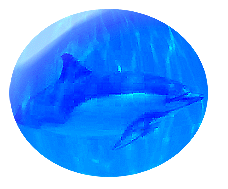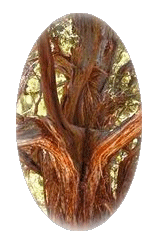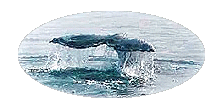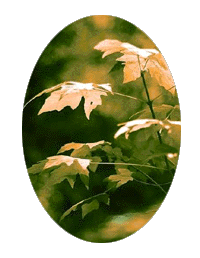On average, a person in contemporary society lives
over 99.9% of his or her life devoid of conscious
sensory contact with attractions in nature. We spend over
95% of our time indoors. We think, write and build
relationships while closeted from nature. This
disconnected state deludes us to believe that our
extreme separation from nature does not influence
our intelligence, sanity or ability to relate
responsibility. The state of the world says otherwise
9.
Unlike nature connected cultures, our detachment
from nature's workings psychologically deprives our
thinking of elements that hold life in balance.
If our disconnection from nature produces problems, it
makes sense to solve them by reconnecting with
nature
13.
Purpose
The purpose of this article is to introduce a
process that helps reverse our disconnection from
nature and its destructive consequences.
When I ask contemporary people to describe their
fondest hopes, they usually include sanity: sustainable
peace within themselves, with society, and Earth.
Although contemporary society has yet to discover or
use a process that produces the sanity we desire,
whales use it successfully and, as if to advertise
their ability, have demonstrated its power. Biologists
say the demonstration was conducted by abnormal whales,
that they deserved to die because the were not the
fittest for survival. However, Biology is but
one of many disciplines, the science of nature
connected psychology tells another story.
 The whale's demonstration took place in 1989 when two
that were trapped in the arctic winter ice bridged
the hostility between Communism and Capitalism. To save
the whales, opposing nations united. So did labor
and industry, corporations and
environmentalists, spiritualists and scientists,
technologists, peacemakers and the media. Close to a
billion dollars was spent to save two whales by cutting
them a path to freedom through the arctic
ice while the world cheered and unified.
The whale's demonstration took place in 1989 when two
that were trapped in the arctic winter ice bridged
the hostility between Communism and Capitalism. To save
the whales, opposing nations united. So did labor
and industry, corporations and
environmentalists, spiritualists and scientists,
technologists, peacemakers and the media. Close to a
billion dollars was spent to save two whales by cutting
them a path to freedom through the arctic
ice while the world cheered and unified.
The whale's effects demonstrate that the attractions we
feel when in contact with a whale, or nature, are but the
tip of an iceberg. The hidden portion of the iceberg
consists of chains of additional attractions that,
like sensory roots, reach every element of our
planet including people. Like whales, as part of
nature we register and contain the means to live
in peaceful equilibrium. What we lack is a process
that enables us to think with and use this
planetary ability.
Hypotheses
Since 1951, my hypotheses has been that we can
produce hope, sanity, peace and balance by engaging
in a process that helps us think like nature works.
Procedure
 My procedure has been to experimentally improve
and engage in the hypothetical process, observe its
effects and improve it again. As an outdoor educator
and researcher, for the past 31 years I have camped
out year-round though the seasons in 83 different
natural habitats while building responsible
human communities. My classroom has been wild America,
over 200 national and state parks, forests, shorelines
and historical sites. I still, today, daily sleep
outdoors in a wild area.
My procedure has been to experimentally improve
and engage in the hypothetical process, observe its
effects and improve it again. As an outdoor educator
and researcher, for the past 31 years I have camped
out year-round though the seasons in 83 different
natural habitats while building responsible
human communities. My classroom has been wild America,
over 200 national and state parks, forests, shorelines
and historical sites. I still, today, daily sleep
outdoors in a wild area.
The results of my work speak for themselves
10.
My references here are original documents that have
been reviewed and published academically and commercially.
I also reference, for educational purposes, the unpublished
raw experiences and thinking of those who have been
involved in my process
6.
As with the whales, my teacher has been the global
ecosystem as it expresses itself in local natural areas.
I seldom use books and the conflicting, limited,
theories of those who abstract, speculate and observe
nature through machines. They seldom live in, think
and build relationships in nature. I find their
words often separate my thinking from truths in natural
areas that otherwise register.
Most literature seldom validates the
sensory/experiential while connected with nature, nor
offers a doable procedure to help us immediately think
more responsibly. In contrast, my social invention
is a hands-on, easily available process that a person
quickly learns and teaches. Its effectiveness
clearly demonstrates we may benefit by creating
moments in nature that let Earth teach, and then
participate in these moments. Significantly, this
gives natural areas added value. Through this process,
in 1965, thirteen years before Lovelock published Gaia, I
was living and teaching a form of Ecopsychology; it
included that Earth acts like a living organism
16.
Evidence
My Natural Systems Thinking Process is a nature
connected psychology, a beneficial science that
demands verbally shared, thoughtful, sensory contacts
with attractions in nature to improve personal, social
and environmental responsibility. It connects our psyche
with 53 distinctly unique attractions found
throughout nature, including our inner nature
26.
By "attractions" I mean things in nature that
draw things together, including "gluons." This
is the opposite of "abstractions," meaning to
draw away from or disassociate.
Nature connected psychology is based on a form of
evidence that contemporary society teaches us to ignore.
It is "Self-Evidence" as in "We
hold these truths to be self-evident." Self-Evidence
is a missing link in how we learn to think. Its
definition is: to validate what we sense and
feel. It critically applies our sense of reason to
what we sense and feel while in consensual contact
with attractions in Nature. It compares these
findings to our Cultural attachments and their effects.
By Nature I mean the non-literate, unadulterated,
biological and psychological attraction process that
has existed for eons before and during humanity's
arrival.
By Culture I mean humanity's abstract, literate,
thinking process, its stories, artifacts and effects.
Validity of Evidence
"At root, ecology is an erotic attitude of
closeness, relatedness and care. We have made it
into a rational/activist project and lost sight
of its heart."
- Thomas Moore
 The Natural Systems Thinking Process is super objective
in that it welcomes all evidence. It includes
sensuous information from non-verbal, transpersonal,
connections rather than dismiss this evidence as
subjective, unscientific, spiritual, psychotic or
fuzzy thinking. The Process enables us to choose
to think and relate like whales and nature work
5.
For decades it has been taught and accredited in more
than 58 Universities and published extensively
16,
6.
The Natural Systems Thinking Process is super objective
in that it welcomes all evidence. It includes
sensuous information from non-verbal, transpersonal,
connections rather than dismiss this evidence as
subjective, unscientific, spiritual, psychotic or
fuzzy thinking. The Process enables us to choose
to think and relate like whales and nature work
5.
For decades it has been taught and accredited in more
than 58 Universities and published extensively
16,
6.
Self-Evidence often consists of natural attraction
sensations and feelings in natural areas that, to help
insure our survival, nature registers in
our consciousness. Although often overlooked,
Self-Evidence is valid because it is:
- REASONABLE: Mathematics, Archimedes'
abstract "Mechanical Theorems,"
is considered to be pure rational fact. However,
the self-evident fact that humanity inherently
senses, feels and learns from natural attractions
is more ancient, true and universal. For example:
The sense of taste: When a natural substance is sweet
it is attractive, often edible and digestible,
it rewardingly satisfies our sense of hunger so,
in time, our sense of reason may validate the
substance as food and allow us to eat it again.
The sense of temperature: If the heat from a fire
burns a person, he or she may learn to trust that
sensation and be attracted to use their sense
of reason or fear and keep a safe distance from the fire.
- AVAILABLE: For survival, humanity is endowed by
nature to continually register attraction sensations
and feelings on conscious and subconscious levels.
- TRUSTABLE: For example: If people
pinch themselves they register and
trust that they feel something. They trust they will
feel something again if they pinch themselves again.
- REPEATABLE: For example: If people
pinch themselves many times over a period of time,
they feel something every time. Other people demonstrate
the same attribute.
- GLOBAL: For example: Humanity throughout
the world senses and feels as well as trusts that
the ability to sense and feel exists in themselves
and others.
- TIMELESS: Records show, and we commonly
reason that humanity, past, present and future contain
and will contain the ability to sense and feel.
- PREDICTABLE: No matter where humanity
goes, if people are conscious they will sense or
feel attractions. Consciousness itself is an attractive
sensation or feeling.
- DIVERSE: There are at least 53 distinct
natural attraction sensations and feelings humanity
can register and thereby know the world
26.
- EDUCATIONAL: Sensations and feelings provide
humanity with a wide range of survival information.
- VALUABLE: Sensations and feelings
enhance survival potentials as well as help establish
a strong sense of self. "I feel therefore I am,"
is as true, significant and important as "I
think therefore I am."
- HONEST: Sensations and feelings always offer
us excellent information about the state of our being.
- WIDE RANGED: Sensations and feelings
help humanity register the many attraction
sensitivities displayed throughout nature by the
plant, animal and mineral kingdoms.
- DEMONSTRABLE: Humanity can often register
what other members of humanity are sensing and feeling.
- INDEPENDENT: Humanity can register and
reason with attraction sensations and feeling that
lie outside the accepted or destructive operants and
dogmas of their culture or society.

- SPIRITUAL: Natural sensations and
feelings enable people to register and relate to
nature connected aspects of spirit and soul that, to
our loss, some parts of society omit.
- ATTRACTIVE: Humanity embraces and
seeks sensation, it is attractive, we normally never
desire to give up our ability to sense and feel.
- INTELLIGENT: The natural world achieves
its perfections by relating through non-verbal
attraction sensitivities, many of which register
as sensations and feelings in humanity and add to
our ability to make intelligent decisions.
- FREE: Sensations and feelings are of, by
and from nature, no culture or individual lays claim
to inventing or owning them or legally restricting
their availability.
- SELF-REGULATING: Sensations and feelings
help regulate and guide each other. For example if a
person is attracted to pinch themselves too hard,
another sense or senses (sense of pain, sense of reason,
or both) attract him or her to stop pinching themselves
too hard.
Self Evident Thinking
Our self-evident, non-verbal way of knowing and
thinking makes up the large, anciently
evolved "Old-Brain" sometimes called the
horse brain. In humanity, the Old-Brain
registers non-literate tensions, sensations,
feelings and emotions. It makes up approximately 90%
of our mentality and is the home of at least 52
different sense groups. It enables us to sensuously
experience nature as nature operates and knows itself.
The remaining 10% of our mentality, the more recently
evolved Cerebral Neocortex or New Brain, consists of
a bonding of the senses of verbal language,
consciousness and reason to produce and act out
abstract stories, be they accurate or
inaccurate, constructive or destructive, connective or
disconnective
7.
Disuse of Self Evidence
 In contemporary society, our New Brain trains itself
to habitually avoid Self- Evidence. We spend over 99.9%
of our thinking in abstract New Brain nature
disconnected stories about how the world works and how
to implement our stories. Thus, we know and manage the
world with only 10% of our and the world's capacity to
make sense. With respect to achieving personal,
social and global sanity, the questionable results
of nature-disconnected abstracting speak for themselves
9.
Our isolated New Brain ego story applauds
itself for its potent conquest of nature. In denial, like
a substance abuse addict, it refutes that with respect
to relating responsibly, the nature disconnected way we
think could define addiction, stupidity or madness
20.
As the classic quotes I include in this article testify,
the idea that nature can help us heal ourselves and Earth
is not foreign to the New Brain. This information
alone, however, is obviously not enough.
In contemporary society, our New Brain trains itself
to habitually avoid Self- Evidence. We spend over 99.9%
of our thinking in abstract New Brain nature
disconnected stories about how the world works and how
to implement our stories. Thus, we know and manage the
world with only 10% of our and the world's capacity to
make sense. With respect to achieving personal,
social and global sanity, the questionable results
of nature-disconnected abstracting speak for themselves
9.
Our isolated New Brain ego story applauds
itself for its potent conquest of nature. In denial, like
a substance abuse addict, it refutes that with respect
to relating responsibly, the nature disconnected way we
think could define addiction, stupidity or madness
20.
As the classic quotes I include in this article testify,
the idea that nature can help us heal ourselves and Earth
is not foreign to the New Brain. This information
alone, however, is obviously not enough.
Unlike whales, our extreme severance from our
inherent, balanced, attraction fulfillments in
nature produces a void in our psyche. We crave our lost
sensory support, sanity and gratification in nature.
In response, we artificially fulfill our cravings to
provide rewards. In the process, we become victims
of destructive rewards and greedy, for when we want there
is never enough. Our economy often operates by
further irritating our natural senses and
then selling us something to stop the irritation.
Although our disconnection from nature and its
destructive effects disturb our sense of reason,
despite excellent evidence to the contrary, few of
us think it reasonable for contemporary humanity to
satisfy its cravings by thoughtfully reconnecting
to attractions in nature
14.
Such denial is typical of addiction. Our problems are often
psychological addictions but are seldom recognized or
treated as such so they continue. We have become
so bewildered (wilderness separated) that we try to
resolve our problems using the same addictive,
nature disconnected, thinking process that produces
them.
Rationale: modeling how nature works
"I go to nature to be soothed and healed, and
to have my senses put in order."
- John Burroughs
For the past forty years, I and many experts have tried
to meet the challenge of reversing contemporary
humanity's disorders. Our goal is to help the
public understand and become involved in how
unadulterated nature prevents our disorders from occurring
in natural systems within and round us. This
consists of sensory experiential learning, not
verbal information alone, for nature knows and conveys
itself non-verbally
6.
The warning labels on cigarette packages exemplify the ineffectiveness of verbal information alone.
 Conceptually, we depict nature's web of life by
letting people model it. This evokes Self-Evidence. We
gather a group of people in a circle and each person
is asked to represent some part of nature, a bird,
soil, water, etc. A large ball of string then
demonstrates the interconnecting relationships
between things in nature. For example the bird eats
insects so the string is passed from the
"bird person" to the "insect person.
" That is their connection. The insect lives in
a flower, so the string is further unrolled across the
circle to the "flower person." Soon a web of
string is formed interconnecting all members of the
group, including somebody representing a person.
Conceptually, we depict nature's web of life by
letting people model it. This evokes Self-Evidence. We
gather a group of people in a circle and each person
is asked to represent some part of nature, a bird,
soil, water, etc. A large ball of string then
demonstrates the interconnecting relationships
between things in nature. For example the bird eats
insects so the string is passed from the
"bird person" to the "insect person.
" That is their connection. The insect lives in
a flower, so the string is further unrolled across the
circle to the "flower person." Soon a web of
string is formed interconnecting all members of the
group, including somebody representing a person.
Thoughtfully, people lean back, sense, and enjoy how
the string peacefully unites, supports and interconnects
them and all of life. This evokes
feelings of belonging, integrity and unity, these are
valid Self-Evidence. Then one strand of the web is
cut signifying the loss of a species, habitat
or relationship. Sadly, the weakening effect on all is
noted. People tell of environmental and social
trespasses they have witnessed or know about.
Another and another string is cut. Soon the web's
integrity, support and power disintegrates along with
its spirit. Because this reflects the reality
of our lives, it triggers Self Evidence feelings of
hurt, despair and sadness in the activity participants.
Earth and its people increasingly suffer from
"cut string" disintegration, yet we continue to
cut the strings. Few dispute this model.
Every part of the global life community, from the
spaces between sub-atomic particles to weather systems,
is part of the web of life. Everything consists
of, and is relationships held together by
webstring attractions. The intelligent, globally
conscious, webstring process by which webstrings
interact produces nature's balanced, unified ways without
our runaway disorders.
When I ask web activity participants if they ever
have visited a natural area and actually seen
strings interconnecting things there, they say no,
that would be crazy.
I respond, "If there are no strings there, what then
are the actual strands that interconnect and hold the
natural community together in balance?"
It becomes very, very quiet.
Too quiet.
Are you quiet, too?
That silence flags a significant missing link in
our thinking, consciousness and relationships.
Without knowing, sensing or respecting the strings
that make up nature and our inner nature, we break,
injure and ignore them. This is the core of our
most tenacious troubles. It is an addictive and
destructive prejudice against the strings that only
subsides when psychologically treated as such.
Until I identify the strings as natural attractions
that people can sense, people don't recognize them and
their value, they have no idea what they are. Once
they experience the strings, people not only
acknowledge them, they also acknowledge that since
childhood they have always known them as sensations
and feelings. Like a little red wagon painted blue,
they suddenly recognize that the nature separated way
we learn to think hides the strings and their benefits
from our consciousness and reasoning.
Webstring Disappearance
The disappearance of the strings from our awareness
and relationships is exemplified by Sharon, an
adult woman.
Sharon negatively reacted to a blue piece of wood
she selected, sight unseen, from a bag of mixed
objects. She blindly choose the wood because
its shape and smoothness attracted her when she groped
and explored in the bag by touch. At first she did not
know why she didn't like the wood when she saw it.
In time, she realized it was a subconscious reaction.
The wood was painted the same shade of blue as the
walls of her room where, as a child, she had
been abused.
As with Sharon, in contemporary society's conquest of
nature, we hurt the strings as we conquer and separate
them from their nurturing origins. To escape feeling
the pain consciously, our inner nature reasonably places
them in our pre-conscious or subconscious mind (20). Thus
the strings seldom enter our thinking or restrain
our destructive conquest of nature around
and within us.
Webstring Attraction Loves
From atoms and molecules to human beings
with developed consciousness, all entities feel
attraction for one another. . . . attraction is the
law of nature.
-P. R. Tarker.
Webstring are natural attractions, forms of love.
Nature consists of wordless webstring loves
7.
A bird's love for food (Sense of Hunger) is a webstring.
So is the tree's love to grow away from gravity and
its root's attraction toward it (Sense of Gravity).
The fawn's loving desire for its mother and vice-versa
are webstrings (Sense of Nurturing).
Webstrings feelingly register in our consciousness
as senses or natural love (attraction, attachment,
affinity, desire,) for being reasonable, love for
sight, touch, and sound; for water, color and community;
for nurturing, belonging and trust; for sex, contact
with nature, and wholeness and love for 41 other
attractions including consciousness and verbalization
26.
When supportively, safely, connected in nature,
each webstring attraction is energized and
fulfillingly enters, registers and plays in our
awareness
5.
Each becomes Self-Evidence, a truth of ourselves and the environment. The Sense of Thirst, our love for water, is a fact as correct as 2 + 2 = 4, as real and true as water, even though it is not one of the five senses that in 1500 BC Aristotle posited
during the cradle of our nature disconnected
civilization.
Each webstring inherently attracts to and blends with
other strings forming a common sense, a globally
balanced consciousness and unity as depicted
in the web of life model. When we don't
recognize Self-Evidence, we can't recognize that what we
call Nature is a process that creates, recycles and
wisely guides ecosystems and their inhabitants through
more than 53 attractions in concert. To our loss,
our separation from nature leaves us to think and
relate using less than eight webstring senses.
Verbal language communication is a webstring enjoyed
by humanity alone. The stories our literacy
webstring produces are a great asset to human survival
when used to help sustain sensory contact with the web
and its intelligent ways. However, literacy becomes a
source of our problems when we psychologically
bond to nature- conquering, demeaning or
disconnecting stories. Whenever we are aware of nature as
a non-sensory label or story, we lose contact
with sensory Self-Evidence. To our loss, this
disassociates us from our biological origins and
attractions in the web of life, its balance, wisdom
and rewards
7.
Webstrings are biologically of, by and from
nature's proclivity to consummate
attractions. Profound disbelief registers on many faces
when I tell the web of life activity participants that
since they are part of nature, the strings are in them
and they can learn to relate to and with them through
a psychological, nature reconnecting,
self-improvement process. They disbelieve
this because webstrings have prejudice, hurt and
fear attached to them. They are often as alien to us as
were the "Indians" to many frontiersmen
and for similar reason: they are to be conquered along
with the rest of nature. Indeed, if we did not conquer
the strings, they would prevent us
from conquering natural systems simply because it would
not feel right.
The Natural Systems Thinking Process is effective because
it identifies the source of our troubles to be our
thinking's disconnection from Self-Evident
webstrings in nature
10.
The Process scientifically addresses this problem by
Today, globally, via the internet and local training sessions, the Natural Systems Thinking Process enables people to enjoy and promote lifeweb connected consciousness, individually, or through distance learning activities, courses and degree programs. They have shown to improve the wellness of our mentality,
being, and ecosystems
10.
Along with empirical studies, thousands of email journal entries, such as the following, validate the webstring reconnection process 11.
The potential of knowing the world through Webstrings and the Natural Systems Thinking Process can be seen in counselor Larry Davies 1996-98 results from offering them to people who were considered almost impossible to reach. A study was undertaken with students who were "uneducatable," because they could not handle regular school programs
17.
Each had been physically or sexually abused, were 180% below the poverty level, drug or alcohol addicted and suffered poor self-esteem, suicidal tendencies, and behavioral disorders. Some were homeless or in correctional settings.
The results were overwhelmingly positive. The students' growth was reflected in improved psychological test scores and analysis, which
showed reduced stress, depression, sleeplessness and drug use along with higher self-esteem
10,
17.
Every student's attendance and academic progress improved, no indications of chemical remission were observed 60 days after the program ended. The students now personally own the activities and rationale for their continued improvement by reconnecting with webstrings in each other and the environment.
Through awareness of their webstring connections the students bonded as a community. They also bonded to a trashed natural area near their forthcoming new school. To protect this area's integrity and availability for future webstring activities, these "incapable" youngsters successfully cleaned up, weeded and restored it, successfully wrote environmental protection
grants, and effectively presented their work to Education Boards and Administrators who were intent on paving the natural area as a parking lot
15.
The student's sensed that the natural area, like their nature, wanted to recover from the abuse it received from society. They said that, like them, it had been: "hurt, molested, invaded and trespassed," "It wanted to become healthy or die." "It felt trashed and overwhelmed."
"It had no power, it needed a fix or help to recover." They wrote: "This wilderness community is being choked by alien plants and stressed by pollution, abandonment and major loss. We, too, are being choked by drugs and alien stories that pollute our natural self. We feel abandoned by our society, treated like garbage, and cut off from nature which fills us with grief. By protecting and nurturing this ecosystem we find the strength to
open our minds, hearts, and souls for the survival of our Mother Earth and ourselves "
20.
Davies' webstring-based study concluded: "The applied ecopsychology story is not to conquer nature, but to flow, dance and balance with nature and each other, as do all other species. It says that nature consists of attractions, that pain, fear and stress are natural attractions, part of nature's perfection. These natural discomforts are nature's way of telling us we don't have sensory support in this moment. They attract us to follow
our other immediate natural attachments. In wilderness settings, our discomforts in nature intensified our natural attractions to nurturing, community and trust. They supported our fun and survival."
Each of us can easily begin to make psychological contributions to personal and global sanity. From this moment on, thoughtfully call each sensation and feeling you or others experience a "webstring attraction". Note how this helps stretch your New Brain thinking into a global frame of reference. Note, too, how your inborn webstring attraction to nature may have been disconnected from nature and attached to artifacts or stories.
Note how it may have been stressed, or can reattach to the web of life in a natural area.
Calling webstrings by their right name helps produce a global consciousness and enables us to further discover and support nature's perfection within and about us. Additional activities and courses strengthen this skill
6.
To begin think more harmoniously with whales and the global ecosystem, any individual or group may discover and teach the Natural Systems Thinking Process by doing the following introductory webstring activity:

